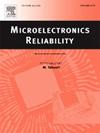On the electrical properties of ALD HfO2 dielectric films for MEMS capacitive switches
IF 1.9
4区 工程技术
Q3 ENGINEERING, ELECTRICAL & ELECTRONIC
引用次数: 0
Abstract
This work investigates the electrical properties of thin HfO2 dielectric films grown by Atomic Layer Deposition (ALD) for application in RF-MEMS capacitive switches. The motivation arises from the need to optimize dielectric performance in these devices, particularly concerning dielectric charging, breakdown behavior, and conduction mechanisms. A key challenge addressed is the influence of deposition temperature on the structural and electrical behavior of the films, which transitions from amorphous to polycrystalline with temperature. The study utilizes a wide range of techniques including current-voltage measurements, impedance spectroscopy, Kelvin Probe potential decay, and Thermally Stimulated Depolarization Currents (TSDC) on Metal–Insulator-Metal (MIM) devices. The key findings indicate that grain boundary formation in polycrystalline films significantly alters the breakdown voltage, charge transport, and trapping mechanisms. It is worth noting that, films deposited at 100–150 °C exhibit hopping conduction and lower leakage, while those at 200–250 °C demonstrate ohmic or Space Charge Limited Current (SCLC) behavior due to crystallization. These results provide insight for selecting suitable deposition parameters to engineer dielectric materials for reliable MEMS switch operation.
MEMS电容开关用ALD HfO2介电膜电学性能研究
本文研究了原子层沉积法(ALD)生长的用于RF-MEMS电容开关的HfO2薄膜的电学特性。其动机源于优化这些器件的介电性能的需要,特别是在介电充电、击穿行为和传导机制方面。解决的关键挑战是沉积温度对薄膜结构和电学行为的影响,薄膜随温度从无定形转变为多晶。该研究利用了广泛的技术,包括电流-电压测量、阻抗谱、开尔文探针电位衰减和金属-绝缘体-金属(MIM)器件上的热激去极化电流(TSDC)。主要研究结果表明,晶界的形成显著改变了多晶薄膜的击穿电压、电荷输运和俘获机制。值得注意的是,在100-150°C下沉积的薄膜表现出跳跃传导和较低的泄漏,而在200-250°C下沉积的薄膜由于结晶而表现出欧姆或空间电荷限制电流(SCLC)行为。这些结果为选择合适的沉积参数来设计电介质材料以实现可靠的MEMS开关操作提供了见解。
本文章由计算机程序翻译,如有差异,请以英文原文为准。
求助全文
约1分钟内获得全文
求助全文
来源期刊

Microelectronics Reliability
工程技术-工程:电子与电气
CiteScore
3.30
自引率
12.50%
发文量
342
审稿时长
68 days
期刊介绍:
Microelectronics Reliability, is dedicated to disseminating the latest research results and related information on the reliability of microelectronic devices, circuits and systems, from materials, process and manufacturing, to design, testing and operation. The coverage of the journal includes the following topics: measurement, understanding and analysis; evaluation and prediction; modelling and simulation; methodologies and mitigation. Papers which combine reliability with other important areas of microelectronics engineering, such as design, fabrication, integration, testing, and field operation will also be welcome, and practical papers reporting case studies in the field and specific application domains are particularly encouraged.
Most accepted papers will be published as Research Papers, describing significant advances and completed work. Papers reviewing important developing topics of general interest may be accepted for publication as Review Papers. Urgent communications of a more preliminary nature and short reports on completed practical work of current interest may be considered for publication as Research Notes. All contributions are subject to peer review by leading experts in the field.
 求助内容:
求助内容: 应助结果提醒方式:
应助结果提醒方式:


